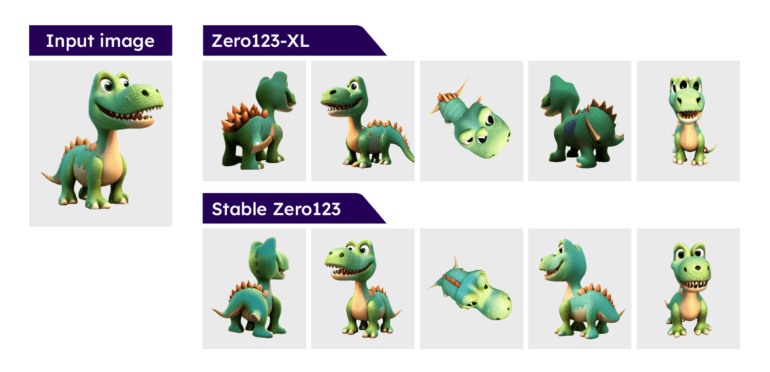TL;DR:
- Stability.ai introduces Stable Zero123, an in-house trained model for 3D object generation from single images.
- Three key innovations: enhanced training dataset, elevation conditioning, and improved dataloader, result in superior quality and 40X training efficiency.
- Stable Zero123 was released on Hugging Face for research purposes.
- Compatibility with threestudio open-source code simplifies the 3D object generation process.
- It is not intended for commercial use, exclusively for research purposes.
Main AI News:
Stability.ai, a leading name in the field of artificial intelligence and computer vision, has made a significant breakthrough with the release of Stable Zero123. This in-house trained model represents a giant leap forward in view-conditioned 3D object generation from single images, outperforming its predecessor, Zero123-XL, and offering remarkable advancements in quality and efficiency.
The Secret Behind Stable Zero123’s Success
Stable Zero123’s superior performance can be attributed to three groundbreaking innovations that have set a new benchmark in the realm of 3D object generation:
- Enhanced Training Dataset: Stability.ai has meticulously curated and filtered its training dataset, meticulously handpicking only the highest quality 3D objects. This rigorous selection process, largely drawn from the Objaverse, ensures that the model is exposed to only the most realistic and detailed objects during training.
- Elevation Conditioning: During both training and inference, Stable Zero123 is provided with an estimated camera angle. This critical addition empowers the model to make more informed and precise predictions, resulting in superior quality 3D object generation.
- Pre-computed Latents and Improved Dataloader: Stability.ai’s approach includes the use of a pre-computed dataset (pre-computed latents) combined with an improved dataloader. This dynamic duo, in conjunction with the first innovation, has achieved a remarkable 40X speed-up in training efficiency compared to its predecessor, Zero123-XL. This means faster and more efficient 3D object generation.
Accessible for Researchers and Enthusiasts
In a move to foster open research and collaboration, Stability.ai has made Stable Zero123 accessible to researchers and non-commercial users by releasing it on the Hugging Face platform. This availability allows individuals to download and experiment with the model, contributing to the advancement of the field.
Creating 3D Objects with Stable Zero123
To further facilitate open research in 3D object generation, Stability.ai has enhanced the open-source code of three studio to support both Zero123 and Stable Zero123. This user-friendly version of the Stable 3D process is currently in private preview. In technical terms, it employs Score Distillation Sampling (SDS) to optimize a NeRF (Neural Radiance Fields) using the Stable Zero123 model, ultimately leading to the creation of textured 3D meshes. Additionally, this process can be adapted for text-to-3D generation, where a single image generated using SDXL can be further refined using Stable Zero123 to produce a 3D object.
Exclusively for Research Purposes
It’s important to note that Stable Zero123 is exclusively intended for research purposes and is not authorized for commercial use. Stability.ai is committed to supporting the research community and non-commercial endeavors while maintaining the model’s integrity and accessibility for educational and exploratory purposes.
Conclusion:
Stable Zero123 represents a remarkable stride forward in the field of 3D object generation from single images. With its innovative training dataset, elevation conditioning, and speed-boosting technologies, it promises to unlock new possibilities for researchers and enthusiasts. By offering accessibility on the Hugging Face platform, Stability.ai aims to accelerate the pace of research and inspire the creation of novel 3D objects that were once thought to be beyond reach.

